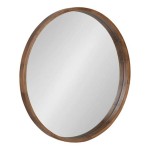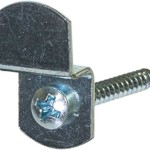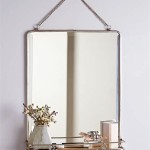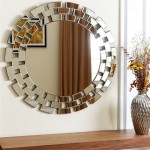How Big Should Your Mirror Be?
Mirrors are a crucial element in interior design, serving both practical and aesthetic purposes. They reflect light, making spaces appear larger and brighter. They also add depth and dimension, enhancing the overall visual appeal of a room. When choosing a mirror, size is a significant consideration. Selecting the right size mirror can transform a room, while an ill-fitting one can disrupt the balance and harmony of the space.
Factors to Consider When Determining Mirror Size
Several factors influence the ideal size of a mirror for a particular space. These include:
- Room Size: A larger mirror will generally be more suitable for a spacious room, as it won't overwhelm the space. Conversely, a smaller mirror will be better suited for a smaller room to avoid making it feel cramped.
- Wall Space: Consider the available wall space and the overall layout of the room. Ensure that the mirror fits comfortably within the designated area without obstructing other furniture or fixtures.
- Focal Point: If you intend to use the mirror as a focal point, it should be large enough to draw attention. Mirrors typically used as focal points are often oversized or framed with ornate details.
- Furniture: Consider the size and placement of furniture surrounding the mirror. A mirror should complement the furniture, not overpower it. For example, a small console table could be complemented by a smaller, rectangular mirror, while a large armoire might require a larger, statement mirror.
- Personal Preference: Ultimately, the size of the mirror should reflect your personal taste and style. If you prefer a minimalist look, a smaller mirror might be more fitting. If you embrace bold statements, a larger, more dramatic mirror might be ideal.
Common Mirror Sizes and Their Applications
Mirrors come in a variety of shapes and sizes, each suited to different purposes. Some common sizes and their typical applications include:
- Small Mirrors (12-24 inches): These mirrors are suitable for smaller spaces, such as entryways, bathrooms, or above a shelf. They can add a touch of personality and style without overwhelming the area.
- Medium Mirrors (24-48 inches): Medium-sized mirrors are versatile and can be used in various settings, including living rooms, bedrooms, and dining rooms. They can be hung above a mantel, a console table, or a dresser to enhance the visual appeal of the space.
- Large Mirrors (48 inches and up): Large mirrors are often used as focal points and can dramatically alter the perception of a room. They can create the illusion of more space, reflect light, and enhance the overall ambiance. Large mirrors are ideal for living rooms, bedrooms, or hallways.
- Oversized Mirrors: Oversized mirrors are typically 60 inches or larger and can be used to make a bold statement. They are best suited for large rooms with ample wall space and can be hung as a standalone piece or as part of a gallery wall.
Guidelines for Choosing the Right Mirror Size
While there are no hard and fast rules for determining mirror size, certain guidelines can help you make an informed decision. These guidelines include:
- Rule of Thirds: One rule of thumb is to choose a mirror that is one-third to two-thirds the width of the furniture or wall space it's placed above or beside. This proportion helps create a balanced and aesthetically pleasing look.
- Consider the Ceiling Height: For rooms with high ceilings, a larger mirror can help ground the space and create a sense of balance. In rooms with lower ceilings, a smaller mirror might be a better choice to avoid making the space feel cramped.
- Experiment with Different Sizes: Before making a final decision, consider experimenting with different sizes of mirrors. You can use painter's tape to outline the size of a mirror on the wall and assess its impact before making a purchase.
By thoughtfully considering the factors outlined above, you can choose a mirror that complements your room, enhances its visual appeal, and creates the desired atmosphere. Remember, the size of the mirror should reflect your personal style and the overall aesthetic of your space.

Bathroom Mirror Size Calculator

Bathroom Mirror Size Calculator

How To Choose The Size Of Full Length Mirror

How Big Should A Mirror Be Over Vanity Ledmyplace

How Big Should Your Bathroom Mirror Be

Mirrors Direct Blog

How To Pick And Hang The Perfect Bathroom Mirror Roomhints

How Big Should Your Bathroom Mirror Be

What S The Perfect Size Bathroom Mirror For Your Vanity Bathtubber

How Big Should My Hollywood Bathroom Vanity Mirror Be Fenchilin








